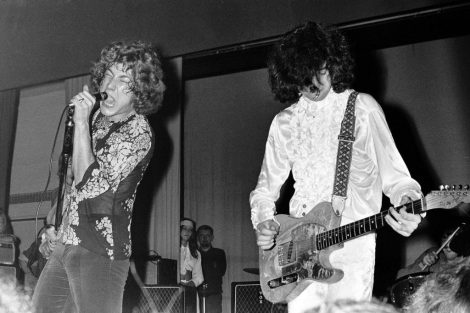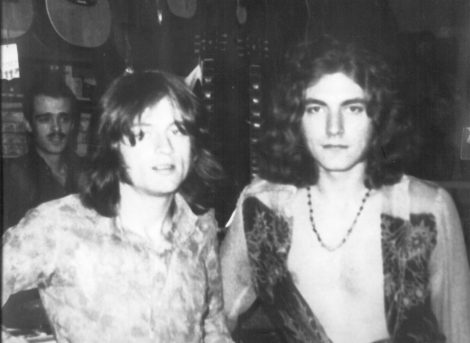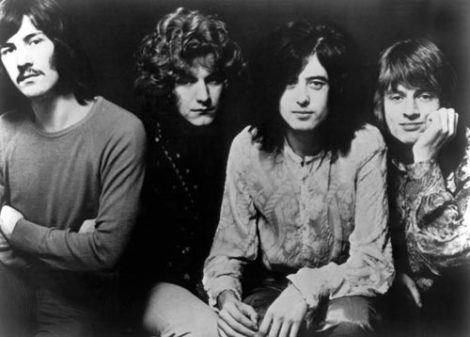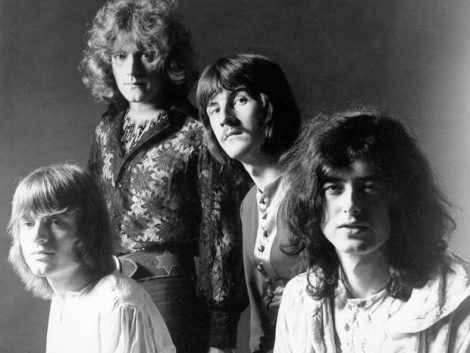On September 7th, 1968, Led Zeppelin played their first live show ever in, of all places, a converted gym in Gladsaxe, Denmark. They weren’t yet billed under their soon-to-be world-famous name but were instead performing under the guise of the New Yardbirds, a relaunch of the British Invasion blues rockers who’d imploded just months before. The only known quantity among this new lineup was guitarist Jimmy Page, who’d funded the tour through Scandinavia out of his own pocket, but that was enough draw a young crowd to the venue, known as Teen Club.
“Their performance and their music were absolutely flawless,” local reviewer Bent Larsen wrote in the venue’s monthly newsletter, “and the music continued to ring nicely in the ears for some time after the curtains were drawn after their show.”

As far as gigs go, this show, which featured several songs that would ultimately appear on the band’s first album, like “Communication Breakdown,” “Dazed And Confused” and “You Shook Me,” paled in comparison to the marathon runs they would undertake at the Forum in Los Angeles or Earls Court outside of London in the years to come, but the momentousness of the occasion can’t be overstated. It was Zeppelin’s first step in their ascent to the top of rock’s Olympus, and Jimmy Page deserves much of the credit for making it happen.
In the spring of 1968, Page was at a crossroads. The highly touted session guitar ace was once again a man without a band. He’d spent the prior two years or so playing in the Yardbirds, first as a dual-lead foil to his childhood friend Jeff Beck and then as the group’s focal point when Beck decided to split in the middle of an American tour. After another quick run through the States, the band suddenly and unceremoniously called it a day when the different members of the group decided they wanted to pursue other artistic avenues.

Page was understandably disappointed, but he had an idea of how he wanted to proceed. Though the guitarist’s move from complete anonymity in London’s many recording studios working with some of the biggest pop and rock stars of the early Sixties to playing sweaty gigs at universities and clubs across the pond in the U.S. was thrilling, but Page also felt stifled by the creative impulses of the Yardbirds’ manager and producer Mickie Most.
Most was a strict disciple of the three-minute pop song, and he butted heads with Page, who was taking note of what the Beatles, the Rolling Stones, Cream and Jimi Hendrix were doing with the album format and wanted to replicate it with his band. Page was especially inspired by a recording session he’d overseen with Beck in May 1966 that produced the song “Beck’s Bolero.”
“The band was John Paul Jones on bass, Keith Moon, Nicky Hopkins on piano, and myself and Jeff on guitars,” he told David Fricke in 2012. “This session was absolutely magnificent, like a force of nature. Keith was having troubles in the Who. He’s going, ‘We should form a band with this.’” While they were passing around ideas about what they might call themselves, Moon came up with a tongue-in-cheek idea. “We can call it Led Zeppelin,’” Page remembered the drummer saying. “’Because it can only go down, like a lead balloon.’ I thought it was a great name, and I didn’t forget it.”
Beyond his talent, reputation and wealth of experience, Page also had a secret weapon. Peter Grant was a 300-pound former professional wrestler and business partner of Most, who’d taken over the Yardbirds’ day-to-day management in their final years. With that band kaput, Grant recognized that his best chances for success in the industry would lie with the slight young guitarist with the long black hair. His devotion to Page during the next 12 years would be total, and as the guitarist began to think about forming a new band, he knew he could rely on Grant to secure the requisite recording contract and help him conquer America, which they both recognized as rock’s next great frontier.
https://youtu.be/Vuj5toLeyY8
The first order of business was to find a singer. The Small Faces’ Steve Marriott was a leading contender, but his manager put the kibosh on that idea, threatening bodily harm to Page if he pursued him any further. Terry Reid, the former singer of the Jaywalkers, and another Mickie Most disciple, was another contender who begged off, but not before recommending a 19-year-old up-and-comer from the Midlands named Robert Plant, who was then fronting a group named Hobstweedle. Page and Grant made the trek north to watch this prospect for themselves.
“[They] were playing at a teacher’s training college outside of Birmingham to an audience of about twelve people,” Page recalled in the Led Zeppelin oral history Trampled Underfoot. “Robert was fantastic and having heard him that night and having listened to a demo he had given me, I realized that without a doubt his voice had an exceptional and very distinctive quality.”

All that was left was to see if this leonine wailer could get on board with the direction Page wanted to go. Page invited Plant to his boathouse on the Thames, and they spent the afternoon talking about music and playing records. In a serendipitous moment, they put on Joan Baez’s “Babe I’m Gonna Leave You,” and excitedly talked about how they could rearrange the song and blow it out. (The cover would appear on the band’s 1969 debut.) Plant was definitely in, but little did Page know at the time that the singer also came with an added bonus.
“I got so enthusiastic after staying down there for a week, I hitched back from Oxford and chased after John, got him on the side and said, ‘Mate, you’ve got to join the Yardbirds,’” Plant said in Trampled Underfoot. “I had nothing to convince him with except a name that had got lost in American pop history.”
The John in question was drummer John Bonham, a lifelong friend and on-and-off bandmate of Plant’s. Bonham was another veritable nobody in the London scene, but Page was taken with his bombastic style from the minute he heard him play. The only catch was, Bonham was currently backing the singer Tim Rose, and making a decent wage out of it too. His wife Pat wasn’t too eager for him to go off on another adventure with Plant either, which made the proposition a tough sell all around. Finally, Grant and Page upped their salary offer, and convinced Bonham to come aboard.

The final piece of the puzzle was to find the right bass player. Fortunately for Page, one of the best in the world fell right into his lap. “I answered a classified ad in Melody Maker,” John Paul Jones told Cameron Crowe in 1975. “My wife made me.” While he’s being a bit flip about the Melody Makerbit, it’s true that John Paul Jones caught wind of what Page was doing, and at the prodding of his wife made the call to get in on it. For the guitarist, who knew and worked with Jones back in his session-player days, the decision to take him up on the offer was a no-brainer. Right off the bat he recognized he’d have a steady hand to help him in the studio, and as the years would show, one of the most dynamic multi-instrumental utility players and arrangers in rock history to help realize his grandest musical ideas.
The four men who would comprise Led Zeppelin came together for the first time in a small basement in Gerrard Street in London on August 12th, 1968. It didn’t take very long for everyone to realize they had something special on their hands. “We got together in this small rehearsal room and just played ‘Train Kept a-Rollin’’ which was a number I used to do with the Yardbirds, and I think Robert knew it,” Page said in 1990.
“At the end of it we knew that it was really happening, really electrifying. Exciting is the word. We went on from there to start rehearsing for the album.”
While they continued to rehearse for their upcoming two-week live run through Scandinavia, an interesting opportunity came up. Texas-born pop singer P.J. Proby was working on his next album and had booked John Paul Jones for the sessions weeks earlier. Rather than cancel, Jones decided to bring along the rest of his bandmates to help work on the record. Page was particularly predisposed to lending a hand, having previously worked in the studio with Proby in 1964 on the eccentric singer’s Number Three U.K. hit “Hold Me.” Thus, the first recordings ever of Led Zeppelin in full flight can be heard not on their own full-length debut, but on Proby’s 1969 album Three Week Hero.
Less than a week later, Plant, Page, Bonham and Jones took off for that first gig in Gladsaxe. “Jimmy Page … has made a great job with the three new men,” Bent Larsen wrote in his review. “They really succeeded.” Larsen closed his write-up with what in hindsight looks like a hilariously massive understatement: “We can therefore conclude that the new Yardbirds are at least as good as the old ones were.”
“I remember everything about that first show,” Grant said in a 1990 interview. It was so … exciting! Just to be part of it was fantastic. There was never a thought of, God, this is going to sell X amount of records. I thought it could be the best band ever.”
Zeppelin played another gig in Denmark the next night, hit Sweden a few days later, and finished up the short tour on September 24th in Oslo, Norway. “Everything was fitting together into a trademark for us,” Plant told Cameron Crowe in 1975 of that early foray.
“We were learning what got us off most and what got people off most, and what we knew got more people back to the hotel after the gig.”
There was hardly time to take a breath when they got back to London however. Page wanted to get Zeppelin into the studio quickly to cut their new record so he could shop the tapes around to several labels. “I wanted artistic control in a vise grip, because I knew exactly what I wanted to do with the band. In fact, I financed and completely recorded the first album before going to Atlantic,” he told Brad Tolinski in the book Conversations With Jimmy Page.
“It wasn’t your typical story where you get an advance to make an album,” he added. “We arrived at Atlantic with tapes in hand. The other advantage to having such a clear vision of what I wanted the band to be was that it kept recording costs to a minimum. We recorded the whole first album in a matter of thirty hours. That’s the truth. I know, because I paid the bill.”
The reported cost for the sessions came out to be somewhere around £1,782. Atlantic ultimately cut them a check for $200,000 to sign them. It was, at the time, the biggest advance ever given to a rock group in music history.

The rest, as they say, is history. Led Zeppelin dropped in January 1969, while they band was in the midst of their first tour of America. It became a runaway success, selling millions of copies, and solidifying them as the dominant group in the decade to come. Page’s gamble had paid off.
“So many people are frightened to take a chance in life and there’s so many chances you have to take,” the guitarist told Crowe at the height of Zeppelin’s commercial and cultural zenith. “I’m attracted by the unknown, but I take precautions. I don’t go walking into things blind.”
By Corbin Reiff

You must be logged in to post a comment Login